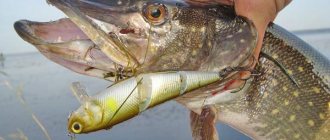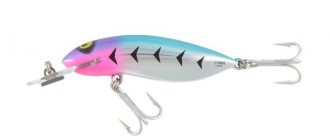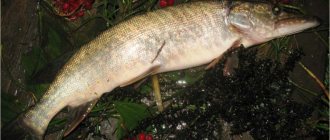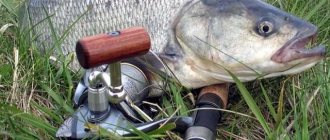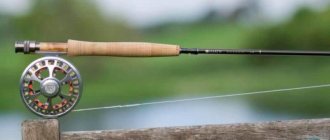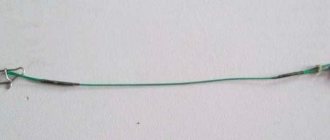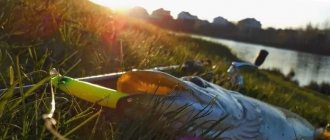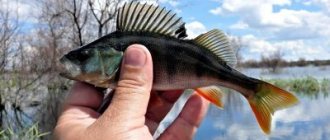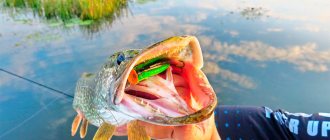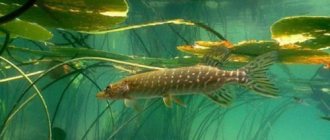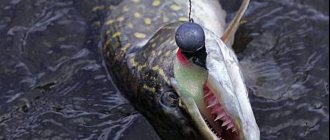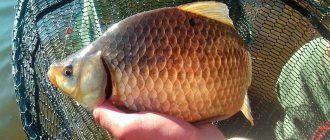Important points regarding the behavior of pike in the spring, the specifics of fishing river backwaters with a spinning rod, the best baits.
In April, as soon as the spring ban on pike fishing ends, I rush to the river with my trusty spinning rod to hunt for a toothy one. First of all, I fish river backwaters, which with the arrival of flood waters turn into excellent fishing grounds.
When to catch pike in the spring with a spinning rod in the river
Pre-spawning food and spawning
In early spring, pike actively feed, trying to replenish energy reserves after a long winter; in other words, the fish begins to eat. Pre-spawning pike feeding begins when the ice has not yet melted and continues until spawning, which the fish begins some time after the end of the ice drift, when the water warms up to 7 - 10°C. Therefore, fishing immediately after the ice melts should bring excellent results.
During spawning, you can forget about the pike bite - the fish do not react to bait at this time. Also, within a week to a week and a half after spawning, the pike “gets sick” - it regains strength and does not feed.
Post-spawning period
After the pike has recovered from the disease, the second stage of the spring pike feeding , which in different regions can last from one to three weeks. Perhaps, this period is the best time for catching pike with a spinning rod in the spring on a river, because it is not always possible to get to a reservoir and catch well during the feeding of pike before spawning due to high water, but the post-spawning zhor is a very convenient time for fishing.
At this time, the pike actively takes any bait, and the catches can be very good. The post-spawning feeding period of pike usually coincides with the flowering of rose hips.
When the post-spawning feeding period is completed, pike activity remains quite high and gradually decreases as the water warms up.
Spring fishing ban
When choosing a time to hunt for pike with a spinning rod, you should remember that in the spring there are restrictions on fishing related to spawning:
- a month-long ban on pike fishing is introduced,
- ban on fishing from a boat,
- ban on fishing in spawning areas,
- restrictions on gear that can be used for fishing at this time.
Specific periods of bans are determined separately for each region.
When does pike start biting in the spring and how to catch it
10 minutes Author: Andrey Goryachev 0
- Pike behavior
- When can you start fishing?
- Specifics of fishing
- Existing prohibitions and restrictions
- Tackle
- Effective baits
- Where to look for a predator
- Time of day and weather for fishing
- Tactics and fishing techniques
- Video on the topic
Spring is the most favorable season for pike fishing. While spring fishing for this predator is prohibited in most public reservoirs, there are no such restrictions in commercial fisheries. For fishing to be successful, an angler must know when to catch pike in the spring and what gear to use.
Spring is the most favorable season for pike fishing. While spring fishing for this predator is prohibited in most public reservoirs, there are no such restrictions in commercial fisheries. For fishing to be successful, an angler must know when to catch pike in the spring and what gear to use.
Catching pike in the spring with a spinning rod from the shore
This is the most affordable and easiest option for a fisherman in the spring. You don't need any additional equipment like a boat for this. However, fishing from the shore has its own characteristics:
It is necessary to pay special attention to places where in the spring pike can be most effectively caught using a spinning rod. These are shallow waters well warmed by the sun, areas with aquatic vegetation and flooded bushes.
Spring fishing from the shore involves the use of rods with small weight (up to 20 grams) and a length of no more than 2.7 meters.
Pike fishing from the shore should be done as actively as possible - locations need to be changed extremely quickly. If after 10-15 casts there is no result, move to a new point.
This is the most affordable and easiest option for a fisherman in the spring. You don't need any additional equipment like a boat for this. However, fishing from the shore has its own characteristics:
October
The best month for a spinner. The predator, following the forage fish, moves to deeper places. There are no more bites on the summer spots; they are empty.
But on the echo sounder you can see how characteristic predatory “crescents” take their positions on all channel edges, slopes, and slopes of underwater mounds. Any type of fishing brings results - trolling, jigging, fishing with large spoons and spinners along the bottom.
October is the best month for fishing for pike with a spinning rod.
The most catchy species is catching pike with a jig. The sizes of any baits used are many times larger than those used in spring and summer.
What does the bite depend on?
The bite of a predator, like the bite of many species of fish, is influenced by a number of factors:
. Fishermen have long noted that if the moon is in any phase, this affects the activity of the fish. And this predator is far from an exception. It is possible to distinguish 2 peaks of the greatest activity of pike: from 1 to 7 lunar days and from 17 to 21. Fishermen also note that the influence of the phases of the moon primarily affects individuals that live in closed reservoirs, for example, a pond, and predators, those living in large bodies of water are less dependent on it. However, you should not take this as an unshakable rule, because... In addition to the phases of the moon, a number of other factors influence the activity of fish.
Lunar phase- Weather . The most suitable weather for catching this predator is cloudy days when a light breeze blows. If there is a little rain, this will also have a good effect on the bite. A decrease in atmospheric pressure or its stability is also observed in the pike bite. For example, before a thunderstorm there is a high biting intensity. In winter, a sharp drop in temperature negatively affects the bite of this predator. And if, on the contrary, the weather is stable, even if it’s minus 20 outside, you can safely go fishing. During the thaw, the pike's bite improves significantly.
- Daily activity . Sometimes pike bites are even throughout the day, but usually pike are caught at the most active time, when the pike goes hunting. The number of exits per day can be large, or it can be 1 - it’s quite difficult to guess, they last 15-20 minutes. Under the most suitable conditions for fishing, active pike bites begin 2-3 hours before dawn and periodically repeat 2-3 hours before noon. And then the second peak begins in the afternoon and ends at night.
- Wrong moon phase . As noted earlier, this factor has a significant impact on fish that live in closed reservoirs.
- The fish does not pay attention to the bait . The reason here is quite simple - the wrong bait was selected or, if you are using an artificial bait - a spinner or a balancer - you are playing with the bait incorrectly. Solving this difficulty is quite simple: change the bait or change the style of play.
- The fish sees the angler or his shadow, which scares it away.
- Incorrect fishing line selected . Excessively coarse fishing line can significantly reduce the number of bites. If visibility is good, the fish will easily notice the fishing line and leash and simply won’t bite.
- Hook size . There is no need to use a hook that is too large, because it will scare away the fish more quickly. It must be in accordance with the size of the bait. Many experienced fishermen note that small hooks allow them to record a greater number of bites than large hooks.
- Lure color . If you fish with artificial baits, then their color plays no less a role than the action. It is not for nothing that fishermen prefer to take with them several colors of bait in order to choose the one that will cause a greater appetite in the fish. If the fish are not attracted to any color, then you can try more universal colors like black and acidic.
- Don't forget to wash your hands . Often the smell of tobacco, aftershave lotion, etc. can remain on the rod or bait, which actually scares off the fish. After all, a predator’s sense of smell is sufficiently developed.
When does pike start biting in the spring?
Somewhere around the beginning of March, the pike already begins to bite. The main thing is that the ice leaves the reservoirs and the river is charged with a fresh portion of oxygen. Pike behave especially aggressively before spawning. The main thing is not to miss this short period of time, which is called the pre-spawning glutton. She really needs nutrients to gain strength and spawn.
It is this period that is very interesting for spinning anglers, since the number of bites can increase significantly, which means that an adrenaline rush is guaranteed.
The period is also interesting because there are no annoying mosquitoes and flies, which makes fishing especially comfortable.
How pike behave in spring:
- During the pre-spawning period. If you can accurately calculate it, the pike will be able to attack any, even the cheapest and simplest bait.
- During the spawning period, pike practically do not feed, except for males, who remain just as active.
- After spawning, the pike rests for about one week, after which it again begins to actively feed in order to regain strength after spawning.
- After warm weather sets in, pike prefer shallows where there are a lot of fry. At the same time, she is not very active, especially in the heat, but early in the morning or late in the evening she may bite on a spinning rod.
It is this period that is very interesting for spinning anglers, since the number of bites can increase significantly, which means that an adrenaline rush is guaranteed.
Features of behavior
- The fish is slow. The pike is weakened after a long winter, and in cold water it is also quite slow. During this period, she will not rush in pursuit of fast-swimming prey and will not attack large fish. This is especially noticeable in early spring, when the water is still cold and the belly is filled with eggs. After spawning, as the water warms up, the fish become more and more active.
- Makes migrations. In the spring, pike in rivers make pre- and post-spawning migrations. Find it at this time in the most common places - in holes, on spits, at edges and slopes, in snags. In the spring, such points in rivers can simply be clogged with migrating pike.
- Pike stay in shallow water. Also at this time, many predators stand in shallow water, where the water warms up faster. Shallow water areas with last year's grass on the bottom are promising for fishing. Small fish rush there, followed by a predator. Small whitefish stay in shallow water until the very end of spring, and somewhere nearby there is a pike. An active predator manifests itself with splashes of water.
Pike spawn in shallow water. In rivers, spawning usually occurs in well-warmed bays. After spawning, a large number of fish remain in these places until summer.
In the spring, the toothy fish often ambushes just a couple of meters from the shore and rushes at the bait at the very end of the spinning line, when the wobbler or spoon is practically under the angler’s feet.
The difference in fishing on small and large rivers and lakes
Most rivers are characterized by a spring phenomenon such as flooding associated with melting snow. On small rivers, the water level does not rise as much as on large ones , since in the latter the water rises not only due to melted snow on their banks, but also due to the entry of additional volumes of water from tributaries.
The best time for catching pike in rivers , especially small ones, is considered to be the short period between the melting of ice on the river and the beginning of the flood. A flood entails an increase in the water level and an increase in its turbidity, which negatively affects both the activity of pike and the possibility of comfortable fishing.
On large rivers during floods, fishing in the riverbed is most often futile , but the rising water floods large areas of coastal areas where pike come before spawning. The water in such places is not as cloudy as in the riverbed, and it warms up quite quickly. As a result, favorable conditions are created for the spawning of pike and the angler can reasonably expect to catch the pre- and post-spawning feast of the predator.
In lakes, the water level in the spring depends on the amount of snow on the banks and on how much water the tributaries bring. The rise of water in lakes is not as critical as in rivers, since the transparency of the water does not decrease as noticeably. Pike should be looked for in shallow water among thickets of last year's vegetation.
All of the above also applies to other predators, i.e. Successful fishing can be either before the flood begins, or after the water level has dropped to normal and it has been cleared of turbidity.
Gear selection
Since pike fishing in the river in the spring usually occurs from the shore at a short distance, a short spinning rod , which will make it easier to accurately cast the bait to a promising point.
Large heavy baits are usually not used, so the rod test must be appropriate.
An excellent choice would be a medium-fast action rod with a length of 2.4 m with a test of 10 - 30 g, such as the “Striker” from Flagman, and a small, reliable spinning reel in size 1000 or 1500, for example, the Shimano Nexave 1000 RB.
With such gear it is convenient to fish on medium and small rivers; it provides accurate casts, and in addition, if necessary, allows you to cast a light bait over a long distance.
0.06 - 0.1 mm in diameter is suitable as the main fishing line : when fishing with small baits, every hundredth of a millimeter is important.
Where and when to fish
March
In most of the European territory of our country, spinning fishing in March is possible only if the weather is warm. Suitable places for fishing may be gullies on rivers, and shore fishing will be more effective. The objects of fishing will be pike, pike perch and perch, and they will have to be caught with jig baits at a considerable depth.
April
In April, broader prospects open up for spinners. On the rivers you can catch the period before the flood and catch pike and pike perch. The pre-spawning zhor of pike allows you to fish in shallow water and at depth. Pike perch can also be active, but you need to find it and pick up bait.
May
In May, you can count on pike feeding - pre- or post-spawning, which depends on the region and weather conditions. The activity of pike perch is increasing - it can be caught both in rivers and in standing reservoirs. By the end of May, the perch revives, although it does not yet begin to flock into schools, but it is already biting greedily - just like in the summer.
Expert opinion
Knipovich Nikolai Mikhailovich
Zoologist, hydrobiologist. I am interested in fishing at a professional level.
Attention! All of the above is true in the absence of certain restrictions on spinning fishing. Otherwise, instead of pleasure, the fisherman will face a serious fine.
Selection of baits
The main types of baits that can be used for catching pike in the spring:
- bite activator;
- jig baits;
- wobblers;
- oscillating spoons;
- rotating spoons.
Jig
You can successfully fish with jig in early spring, immediately after the ice melts, when a large number of pike still remain at depth.
When hunting for deep-sea pike, jig fishing should bring the best results.
Twisters and vibrating tails should not be large; their optimal size is 5–8 cm. The weight of the jig head is selected based on the strength of the river current; often a jig head weighing 10–15 g
Oscillating spoons
Heavy spinners can be used to catch passive deep-sea pike in early spring, while light, small spinners are suitable for hunting predators in shallow water.
A well-chosen bait for the situation and skillfully presented is the key to success when catching fish in the spring in almost any situation.
Wobblers
It is this type of bait that allows you to perform slow retrieval in a certain water horizon, since each wobbler model has a certain depth of depth. Therefore, when catching spring pike in shallow water, a wobbler is perhaps the best bait.
Minnow-shaped wobblers of small size, about 5 - 8 cm long, perform well .
Spinners
Rotating spoons create strong vibration, which allows you to tempt even pike sluggish after winter in cold water to bite. They work great at depths of up to one and a half meters, where spring pike hunting most often occurs. The optimal sizes of turntables are No. 2 - No. 4.
Fishing gear
The choice of rod, equipment and bait most of all depends on the specific conditions and preferences of the fisherman. However, several recommendations can be made:
- For fishing on the river and in ice holes, you should choose the longest possible rod, so you don’t have to get too close to the edge of the ice. This is especially important when the ice near the coast manages to freeze overnight.
- Choose a fairly stiff stick, even if the weight of the bait is much lower than the test of the rod. The fact is that pendulum casting is used more often than others, and with such a cast the body of the rod has little effect on its range, but it is easier to control the accuracy and flight with a rigid stick.
- If you go to an unfamiliar lake for spring pike, it would be best to choose the northern shore; it is well illuminated by the sun from the southern side and the ice melts here earlier.
- Do not use a rubber boat; choose options with a hard bottom. Often you will have to overcome the edges near the shore while sitting in a watercraft and push off on the ice, with the risk of tearing the rubber bottom.
- For fishing, it is better to use fishing line; the cord will have to be treated against frost, which may occur in the morning. Such pike fishing will not have a very good effect on its durability.
- It is better to avoid wading fishing unless you have special clothing and equipment. Spring water is very cold, despite the hot sun, and catching one or two squints is not worth rheumatism or a cold.
Spring ice is a fairly loose mass that can be a source of snags. If you are “lucky enough” to get your bait on the ice, it is quite possible to break through it and get caught on it from below, or the hooks will simply get stuck in the thickness, then pulling them out is more difficult than from snags. It is better to use light baits with non-catching elements - jigs, spinners. The use of wobblers with a large number of hooks should be abandoned, or the tees should be replaced with doubles and single hooks.
The fishing reel should start well and give a stable speed; it is better to use models with a high reeling speed; it is sometimes important that the bait immediately starts playing after casting and diving. Pike are active in the spring and, if present, almost always take immediately. It is also advisable not to wind the cord slightly; a long casting distance is not required in the spring, but there will be fewer loops, especially if you use baby oil to prevent frostbite from such a base.
A few words about clothes. It’s worth taking a fairly warm jacket with you, which you can then take off during the day if the sun starts to get hot. The same can be said about trousers - it’s better to take warm ones and another one underneath. Be sure to wear a hat and warm shoes, gloves will also be useful.
Victoria Leshchenko
I've been working hard in the fishing tackle department for the past six years. I can help you assemble almost any gear.
Ask a Question
Polarized sunglasses help a lot in spring; the spring sun hits straight into your eyes, making it almost impossible to fish without this accessory. If you don’t have polarized ones, regular dark glasses will also work, but worse.
Fishing technique
The key to success when fishing for pike in the spring is slow retrieval and fishing over a large area of water. However, it should be noted that river pikes are still more active than lake pikes, and when fishing in a river, it is usually not necessary to choose the slowest retrieve pace possible.
Best fishing spots:
- pits,
- eyebrows,
- dumps,
- snag,
- shallow creeks and bays,
- shallow areas with remnants of last year's grass.
Since fishing in spring takes place at shallow depths, places with bottom irregularities (bumps) or obstacles (snags) can be determined by the nature of the water surface.
Points where the surface current forms different “spins” should be fished especially carefully.
In the spring, pike often follow the bait all the way to the shore, but do not take it and return to the ambush site. In this case, you need to try changing the bait to a model that plays more actively or has a different color.
Since in the spring, predatory fish often lie in ambush right next to the shore, it is necessary to continue the spinning line until the end, literally up to the angler’s feet. Often the bite occurs two meters from the shore.
Thus, the basic rules for success when fishing for pike in the river in the spring:
- fishing in shallow water (at depths up to 1.5 m);
- fishing of large water areas;
- use of small baits;
- slow retrieval of the bait;
- wiring all the way to your feet.
The best weather for pike fishing
Pike is an indigenous inhabitant of fresh water bodies, which is widespread in Europe, Asia, and North America. An adult reaches one and a half meters in length and weighs more than 5 kg. In some cases, fishermen mentioned giants exceeding 20 and 25 kg. The average size of the “toothy” fish, which readily falls for the bait, rarely reaches such values; usually the catch contains individuals from 1 to 1.5 kg. Sexual maturity of the predator occurs in the fourth year of life. The fry feeds on small worms, invertebrates, and other underwater creatures. As young pike grow older, they switch to large prey - small fish, tadpoles, frogs. Seasoned beauties do not disdain waterfowl rats, as well as birds.
The predator, like peaceful fish, reacts to changes in external habitat conditions, which can favorably or negatively affect the mood of river inhabitants. Fish activity and bite depend on various factors:
Fishing for pike in winter
Many fish (tench, crucian carp) hibernate with the onset of winter. But not pike. And in the winter season, this individual continues to move and feed. However, its activity is still reduced and don’t count on a particularly good catch. This fish does not gather in schools, but lives and feeds separately. And even if pikes intersect with each other, then great friendship does not arise between them.
An excellent time to catch pike fraternity is on the first ice. During this period, fish very often go out into shallow water , hunting for fry. But she is very careful and even the slightest rustle can scare her away. If the ice is covered with snow, then fishing for this fish will bring more fruitful results. In general, it is difficult to predict what is good for catching pike. She bites best on live bait. But a spinner, as well as a balancer, can do their job perfectly.
Fishermen call this month “dead winter.” The predator is passive and fishing is very sluggish even with live bait. You can, of course, fish in places where other fish live or in deep holes. But this should be done on a warm day and exclusively during daylight hours.
A good option for winter fishing is girders and set-ups. They must be placed at depth and near thickets of grass, as well as in places where other fish stay.
The last month of winter brings with it the smell of spring and all predators, including pike, begin to actively move. Fishing during this period is very good. The predator is hungry and ready to swallow any bait. It bites best on live bait, spoons and balance beams. The girders should not be ignored either. The pike moves actively and catches all types of bait.
In May, predators continue their spring feeding. After spawning, pike are hungry and bite on many types of bait. True, most often smaller individuals are encountered. Large fish get sick after changing teeth and lead a more sedate lifestyle. At this time of year, the reservoirs have already warmed up, and young grass is actively growing. Pike scurry through the thickets in search of prey and this is the best place for successful fishing. You can catch fish on spinners or active wobblers, but most readily they bite on live bait. In May, by the way, the ban on spinning fishing begins.
When to catch pike in the spring after spawning
Most of us wonder in what month do pike spawn? Immediately after the ice melts in water bodies, pike spawning begins. Smaller individuals spawn first. The duration of spawning varies from one to one and a half weeks. In central Russia, this period falls in the middle or end of April. After the end of spawning, a couple of weeks later, the feeding of medium-sized pike begins, which also does not last long; approximately, you can count on catching pike until mid-May. Then large individuals spawn; if you happen to see this unforgettable sight, it will remain in your memory for a long time. Giant “logs” swim up to the shore almost at arm’s length; we don’t come across these often, but the chance remains.
After spawning, medium-sized “grass pencils” actively attack juvenile fish or a floating spoon or wobbler nearby. During the post-spawning period, you can catch pike in the vicinity of growing reeds or ragosa using live bait using a rod or using spinning rods using artificial baits. The bait - popper - becomes very popular during this period; catching pike with it is very spectacular, since the fisherman visually observes the attack of the fanged predator on the bait. Having seen the poper, the pike begins to pursue more actively.
Another successful option for catching pike is fishing with mugs or rollers. For this you will need a boat. Skillfully placed circles or rollers along the cable will bring positive results. More details in the article on catching pike with mugs.
There is also the “old-fashioned method” of catching pike in the spring: a fishing line with a sinker, equipped with a double, is tied to bushes located near the reeds, bait is attached and thrown into the water. A kind of donkey gives good results.
Spring pike fishing continues throughout the day from early morning until sunset.
At what temperature does pike spawn? — For pike, +6 degrees is enough to start spawning.
Features of pike fishing in the spring months
- March. The pre-spawning period is one of the most interesting and successful for pike fishing. It is better to fish in the first two weeks after the ice melts, before the arrival of muddy water, which makes it difficult to tempt fish to bite. The best time of day for spinning fishing during this period is morning and evening. Air pressure and temperature in March are very variable; a good bite can be observed in both sunny and cloudy weather.
- April. In the rivers of most regions, pike spawn in April and get sick after spawning. At this time she does not bite. In addition, in April the flood usually begins, during which the pike stands in the coastal zone, among the bushes and reeds. Spawning, one to two weeks after spawning and spring flood time are not the best times for fishing. Thus, fishing for pike in April with a spinning rod on the river is a waste of time and effort.
- May. In May, pike begin to bite well on spinning rods on small rivers. The water in the river falls and becomes lighter, and the rapid growth of algae begins. Pike can be caught both in the coastal zone and at depth. Surface wobblers, spinners and light jigs work well
If you know where, when and what baits pike bite in the spring, fishing at this time of year will bring excellent results - both in terms of the number of tails and the size of trophies.
What baits to use for spring pike fishing
The answer to this question is quite philosophical, since it all depends on the reservoir and your skill; from personal experience, jerkbaits and oscillating spoons work well. For some reason, in the reservoirs where I fish in the spring, wobblers and spinner spoons do not work at all, perches bite well on them, pike are caught only in the summer.
Speed, technicality and wiring activity are important.
The selection of baits should be chosen based on the spring fishing period, of which there are two: before and after spawning.
We recommend: Review of fireflies and alarms for night fishing from AliExpress
From personal experience and the experience of other anglers, the following baits work well at this time:
- Jig - lures and jerkbaits, they work quite well, but with skillful retrieve. It is important to use slow movements and long pauses.
- Wobblers - floating and rattling ones work well. It is important to use slow wiring.
- Oscillating spoons work great for pike, it is important to slowly raise and lower them.
It is important to understand that when a female pike goes to the spawning grounds, she needs food, and small male pikes are an excellent food during this period.
Females actively hunt them during this period. Therefore, before spawning, baits imitating small squints will be excellent baits.
If you want to catch a large trophy pike and they are in your area, then use large lures as bait.
After spawning, the realism of the baits does not play a special role; the naturalness and technique of their placement are important. Theoretically, you can even fish with homemade spoons made from spoons; with skillful fishing they will give good results.
The color of the bait should be chosen based on the color of the water in the pond; the darker it is, the lighter the bait and vice versa. You need to understand what color the main food supply in this body of water is; based on these two points, choose the appropriate color of the bait.
Fluorocarbon or steel leaders work well as leaders.
Regular short leashes made of monofilament fishing line with a breaking load of 12-15 kg work well. Due to their tensile properties, they absorb a sharp blow during an attack, and also provide, due to their flexibility, a better performance of the bait, but they have to be changed quite often, sometimes the pike bites them and leaves.
Select the spinning rod and reel based on the baits you will be fishing with. The tackle should be balanced, comfortable and absorb sharp pike strikes.
When fishing during this period, I recommend learning how to use the friction brake of the reel to avoid damage to the spinning rod.
The best baits suitable for spring fishing or what to fish with?
Wobblers
After using wobblers numerous times, you will learn to jerk, which will make the fish attack the bait even more.
A suspender (sinking wobbler) is suitable with it you can recreate the effect of a sinking bait. This will work in favor of the fisherman, since in the spring the pike is not yet very active and you do not need a fast-swimming bait. The fish may simply not pay attention to such bait.
Wobblers are distinguished:
- floating (remains in the water after casting);
- sinking (have a large mass, suitable for long casts);
- suspenders with neutral buoyancy (the bait hangs in the water, simulating a sick fish).
Types of wobblers:
- Minnow. Outwardly they resemble the body of a bleak. With the help of a special “tongue” they vibrate in the water column. Some imitate the movement of a snake, others waddling from side to side.
- Sheds. Designed for fishing in water bodies with fast currents. The shad's body is quite wide.
- Fet. A good choice of bait for pike in the spring on a spinning rod. With a thick body and blob-like appearance.
You might want to make your own wobbler. For this it is better to use wood or foam. Cut out 4-10 cm shape of a small fish, make a slit near the mouth, install holders near the tail and belly and cover with paint and varnish.
Several companies can be distinguished
- Jaxon,
- Owner C'ultiva,
- Strike Pro.
Spinner (rotating spoon)
Favorite equipment for experienced fishermen. With its oscillation it is capable of luring a hungry pike. It is necessary to cast at a short distance from the fish. The pike will not resist throwing during a long retrieve. At the beginning of May, spinners displace all other baits in terms of the number of fish caught.
For pike fishing, rotating lures of the “Comet” type are most suitable . Mepps and Bluefox have proven themselves.
The spinner is led in a straight line (controlling the spinner, sometimes changing the wiring horizon), in a wave-like manner (similar to a jig, but do not let the spinner fall to the bottom, making 3-4 turns with the reel).
We suggest considering the following companies:
- Mepps,
- Kuusamo,
- Spinnex,
- Wirek,
- Jackson,
- ACME,
- CONDOR.
Oscillator
Having determined that the water is cold, use a lower speed with the oscillator and vice versa. Pike's metabolism decreases in cold water. However, exceptions are not uncommon. Use the wiring method that is optimal for you.
Spreaders are often used in the fall, so in the spring they are not in great demand among fishermen. If you use them in the spring, they should be in provocative colors with a holographic sticker or a fish with painted scales, reminiscent of a perch.
Pay attention to such manufacturers as:
- Atom,
- Successful,
- Colored,
- Syclops,
- Effzett,
- Rassanen,
- Kastmaster,
- Eira.
Spinnerbaits
Optimal for overgrown reservoirs. They must be large in size (from 12 cm in length to 20 in height). The silicone skirt should be full and long. Firmly hook the hook onto the frame. Small petals will not attract large pike, and we are not interested in small fish.
It is good to use a spinnerbait along the edge of the grass, near the reeds. Completely unsuitable in areas with duckweed on the surface of the pond. Beware of stumps and snags so as not to lose your bait.
If you have not yet made your choice, then we offer you several worthy options:
- Pike,
- spinner,
- Bomber,
- Booyah.
Silicone baits
Pike can bite on any silicone and still prefer twisters and vibrotails. The choice in fishing stores is great; you can buy worms, lizards, and leeches. The leash when casting silicone bait is characterized by long casting and waiting for it to touch the bottom. Afterwards there is a slow retrieve at the bottom.
The following silicone baits are popular :
- Mr. Twister,
- Mann's, Relax,
- Bass Assassin.
Foam rubber baits
We can say with confidence that these are the best lures for catching pike with a spinning rod in the spring, if they are made by the fisherman himself . The purchased ones have many disadvantages.
There is a small selection of sizes and colors on sale, and the polyurethane layer of large types gives the bait unnecessary weight.
If you decide to make a foam fish at home, you need to cut it in half, insert the hook into the cut and glue it with glue. For an offset hook, cutting is not necessary.
This type of bait does not have its own trajectory of movement, so you need to get used to changing the types of wiring, constantly making wave-like movements and movements along the bottom.
Jig, twister and vibrotail
The most successful jigs are edible, and then regular silicone. Try to choose twisters and jigs of bright colors that will provoke the pike to hunt. The size of the jig head must match the bait and the fishing location.
In still water, ten-gram weights are optimal, but in the presence of a current, fifteen grams are needed.
At great depths and strong currents, you can’t do without thirty-gram weights and massive silicone baits. When fishing, take a variety of different jigs with you, as pike sometimes cut them off.
Bait as bait
perch or roach work well Be careful when baiting with live bait; it is better if the pike bait on the spinning rod is still alive in the spring. Check the activity of the live bait as you go.
For fishing in lakes, live bait is placed on a hook by piercing its back with the hook. On a river, pierce through the gills or attach the bait by the upper lip. When hooked in a timely manner, the hook will pierce through the corner of the pike's mouth or the roof of the mouth.
To catch live bait, use a bait lift. You put it in the water and it attracts a lot of fish. Throw in bait or create turbidity. After you see the fish flickering, raise the trap sharply. You can use a float rod to catch live bait.
Top 10: The best lures for pike in spring
- Daiwa TD Popper Zero (350 rubles). A beautiful popper with excellent casting range and realistic sound effects. It has proven itself to be excellent for catching large fish.
- Fishycat Popcat 85F (370 rubles). Very strong and durable popper. Thanks to its expressive sound, it is able to lure pike from a long distance.
- Zip Baits Khamsin 70 SP (690 rubles). Excellent casting range, good balancing. Tried and reliable bait.
- Tsuribito Hard Minnow 95 F (320 rubles). It is characterized by high strength. Active play is possible even with very slow wiring.
- Jackall Squad Minnow 80 SP (510 rubles). The best choice for those mastering twitching.
- Booyah Pikee . High-quality spinnerbait with a willow leaf blade and a steel leader.
- Vintage Eppinger Dardevle Spoon (300 rubles). Classic turntable. Notable for its sweeping game and variegated color.
- Blue Fox Vibrax Super Bou (780 rubles). Large pinwheel with two petals. Creates natural vibrations.
- Mepps Double Blade Aglia (300 rubles). Brightly colored bait with two petals. The optimal choice for fishing in thickets.
- Mepps Syclops (145 rubles). Available in a wide variety of colors, including Jamaican colors, the popular spinnerbait is capable of attracting the most lethargic pike. Great for vertical jigging.
You can catch pike in the spring with almost any bait . But sometimes the pike turns out to be a little more capricious than usual, and then you have to experiment. Fortunately, there is an immense amount of lures, and there is not a single pike that can resist them all.
When can you start fishing?
In order to catch pike with a spinning rod in the spring, there must be open water - at least in part of the water area. In stagnant bodies of water, the melting of ice usually begins from the coastal zone and in the gullies that appear, you can try to catch a pike. In rivers, especially large ones, the situation is somewhat different - gullies can appear where the current is strongest, i.e. not in shallow water, but on the riverbed. You can successfully catch pike in these gullies with a jig-spinning rod, standing on the edge of the ice, naturally, being careful.
